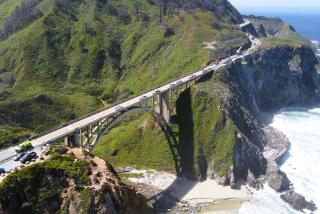More rough roads ahead
More than a quarter of California’s 49,477 miles of highway lanes are considered in disrepair, an amount so far above normal that the state, by some measures, has the second-worst road conditions in the country.
In Los Angeles County and the Inland Empire, Caltrans records show that about 30% of the highways are in disrepair -- most suffering from major structural distress.
Caltrans officials expect the deterioration will continue despite a $20-billion transportation bond measure approved by the state’s voters in 2006.
Officials predict that at current spending levels, more than a third of all state highway miles will fall into disrepair by 2017.
“We’ve got a system now that is getting old,” said Caltrans Director Will Kempton. “We used to have a fairly new system. . . . You’d come in from Nevada and you could notice the difference in the roads. California was at the top. Not any more.”
Poor pavement contributes to traffic congestion on busy highways because motorists tend to slow down on rough surfaces, Caltrans officials say. Also, rough roads can damage tires, rims and suspensions, leading to breakdowns, which add even more to traffic congestion. Damaged pavement costs the typical motorist from $500 to $700 a year for repairs, according to studies by Caltrans and the American Highway Users Alliance.
Caltrans’ goal is to have no more than 10% of the highway system in disrepair at any time. Yet, by 2007, distressed lanes had reached 26% of the state’s total highway mileage.
Helping to accelerate the decay is the advanced age of the freeway system. As much as 90% of California’s freeway network was built between 1955 and 1970 and had a design life of 20 years, said John Harvey, a civil engineering professor at UC Davis.
Because money available for repairs has fallen far short of the need, Caltrans has been making temporary fixes, such as asphalt patches, instead of using longer-wearing concrete that lasts 40 years. Over the long run, officials say, temporary fixes can end up costing taxpayers twice as much as a permanent repair.
“We would like to do new concrete instead of constant asphalt overlays, which have to be redone every five or 10 years. It’s like a big Band-Aid, but that is all we can afford,” said Kirsten Stahl, a civil engineer in the Los Angeles Caltrans district who works on highway rehabilitation projects. State officials say deterioration accelerates if a road is not repaired quickly.
Stahl spoke during a tour of damaged pavement on the 710 Freeway, one of the most-repaired state routes in Los Angeles County, and a highway that takes heavy pounding from tens of thousands of daily truck trips. A $400-million project to improve the median barriers, shoulders and ramps of the 710 is underway. But that is only a start on the highway’s problems.
“It is getting harder and harder to do basic maintenance,” Stahl said. “You need to do the remedial work as soon as possible.”
--
More to Read
Sign up for Essential California
The most important California stories and recommendations in your inbox every morning.
You may occasionally receive promotional content from the Los Angeles Times.











